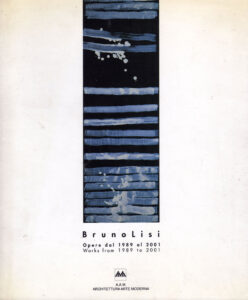In the early sixties Bruno Lisi, just turned twenty, made his debut in a season moving rapidly away from the tired and rampant Informal. Shortly afterwards various other ways out were pursued: from Pop Art, noisily suggested at the 1964 Biennial Exhibition in Venice when object poetry exploded and spread from the Giardini di Castello and from the United States Consulate to Dorsoduro, to the more insinuating ones of conceptual and minimal art with relative constructive regenerations and strict diets that will bring about an elementary reworking of the glossary of painting, reduced to a monastic rule. In this climate that is more flottant than flou, without giving in to new and other fashions, Lisi turns towards a sombre but not severe abstract, based on uniform colour, on a thin impasto, giving a luminosity as intense as it is discreet.
I don’t know if Lisi saw the splendid and well-timed Rothko exhibition held in 1962 at the National Gallery of Modern Art, but the show of the American painter should undoubtedly have been a lesson, better yet a stimulus to pander to his own substantially lyrical nature, and at the same time refining a routine of meditation, of nourishing silence. From then on, although his painting evolved in cycles and series, it always remained recognisable. Painting that stakes everything on surfaces but couldn’t live without the continual vibration, technically very elaborate (we mustn’t forget that Lisi is an expert at restoring and frescoes) of colour-light. Lisi intervenes in these spaces with moderation. He is definitely a virtuoso of brief painting, his often furtive images have the sharp effectiveness of apparitions, of absolute verses. A conciseness arising from modesty was reinforced little by little by daily exercise in concentration, so that today the path of the mental and emotional circuits strikes quickly, nearly a transfert, in gestures and in signs and images. These results are evident and surprising, above all in his works of the past two years. Large blue or indigo canvasses (I would like to call them skies because of their characteristic luminous air) crossed by wide brush-strokes of a colour that is more intense but not less transparent, actually aerial. One or two or three wide, irregular lines, stopping occasionally, briefly, then stretch out as though starting from far away after the prolonged encounter with the surface, and continuing on their way, leaving only the echo inside us. This gesture, generated by the unconscious and well directed by reason, thus becomes the subject of the painting. A gesture that invades the canvass in a fertile embrace.
(translated by Helen Pringle)
(from the catalogue of the exhibition: “Opere dal 1989 al 2001”, Galleria A.A.A. Palazzo Brancaccio, 26 November 2001-26 February 2002)
